北师大版(2019)选择性必修第四册 Unit 10 Connections Writing Workshop 课件(23张PPT)
文档属性
| 名称 | 北师大版(2019)选择性必修第四册 Unit 10 Connections Writing Workshop 课件(23张PPT) | 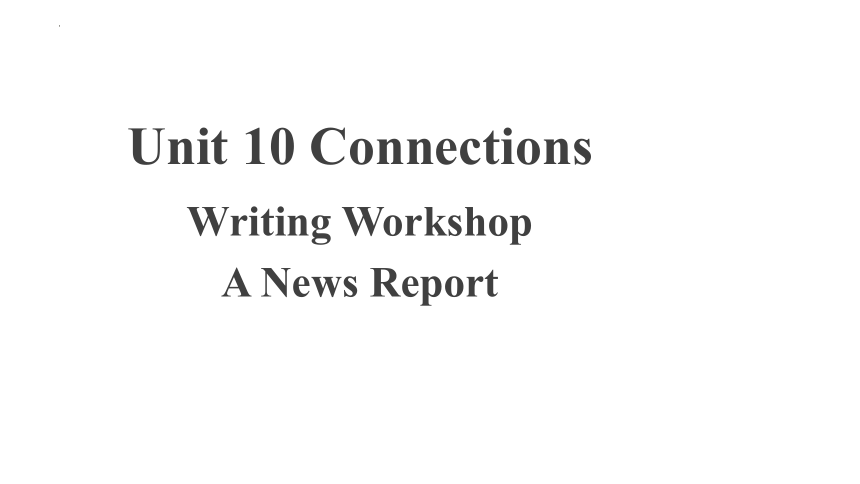 | |
| 格式 | pptx | ||
| 文件大小 | 206.1KB | ||
| 资源类型 | 教案 | ||
| 版本资源 | 北师大版(2019) | ||
| 科目 | 英语 | ||
| 更新时间 | 2022-12-26 21:00:34 | ||
图片预览

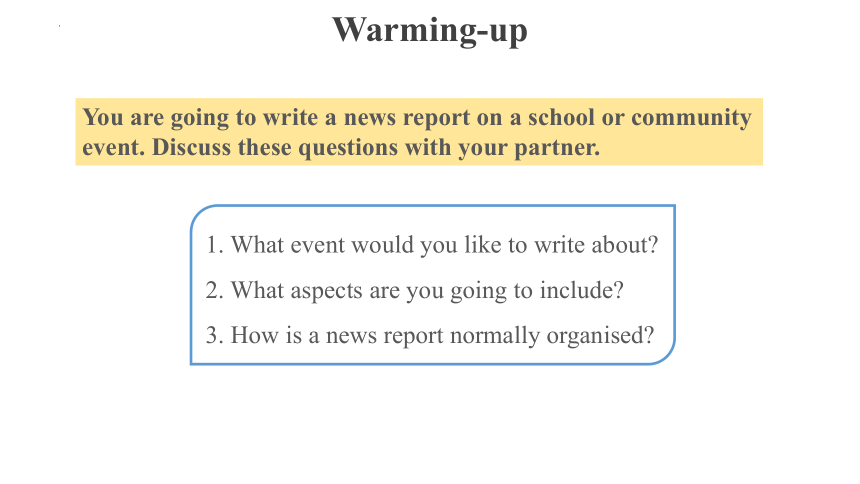
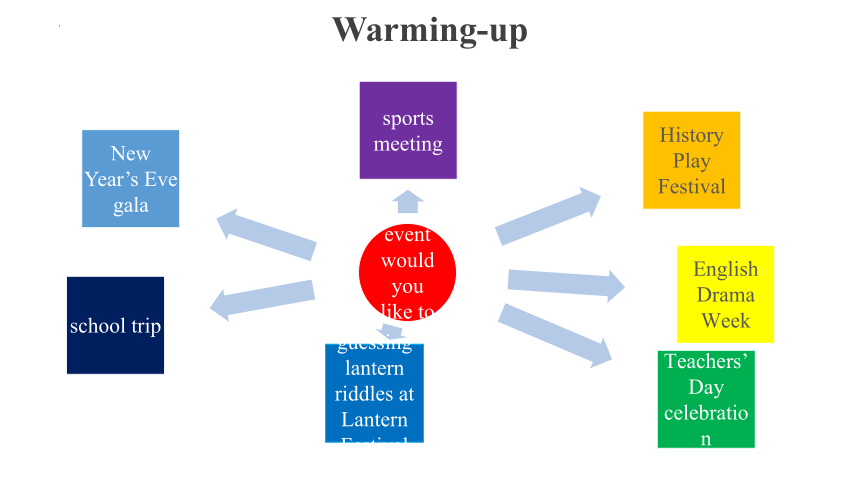
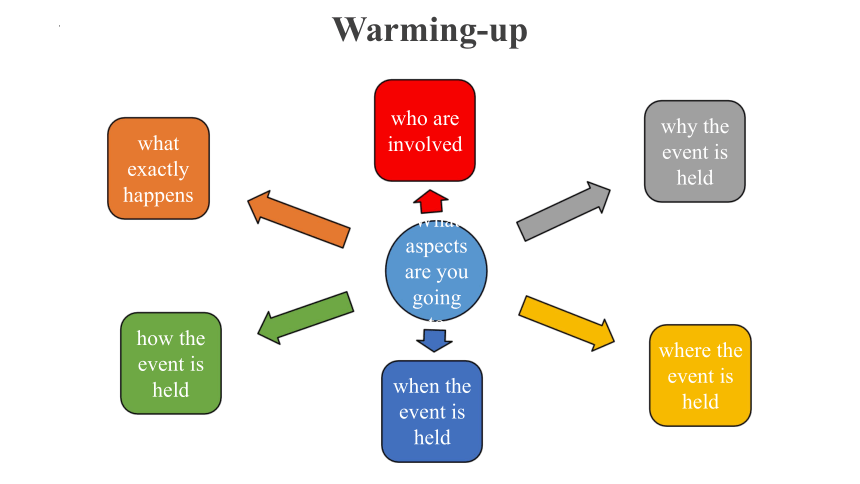
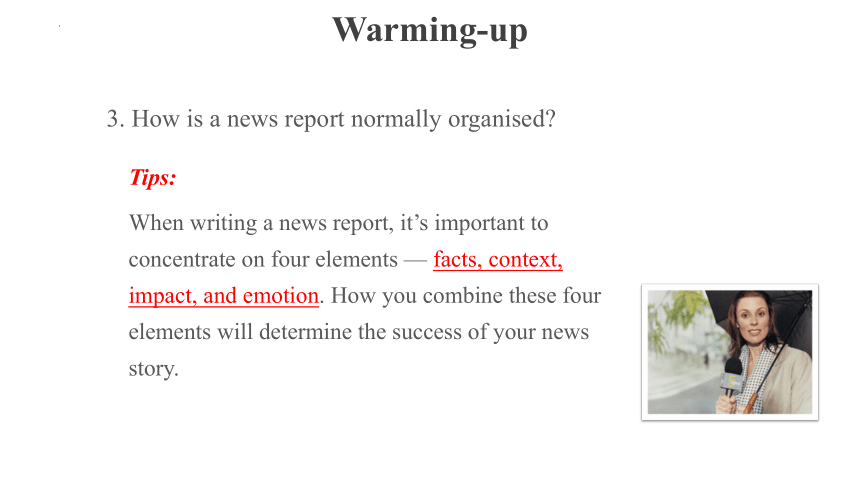
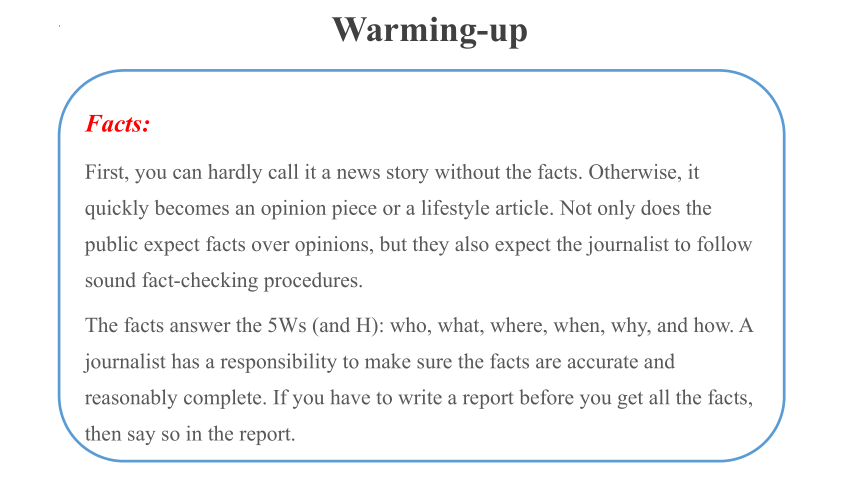
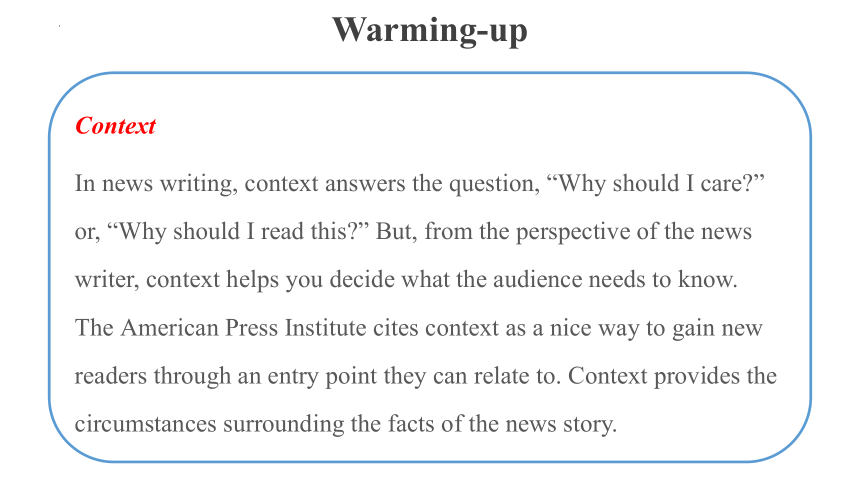
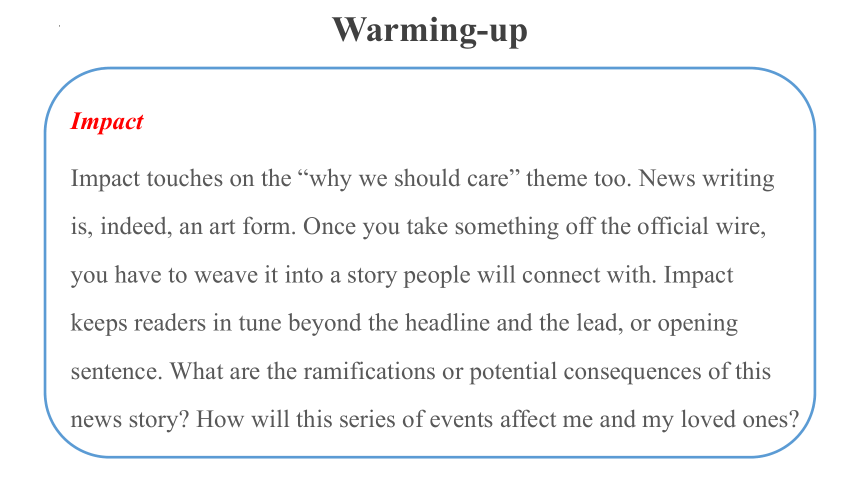
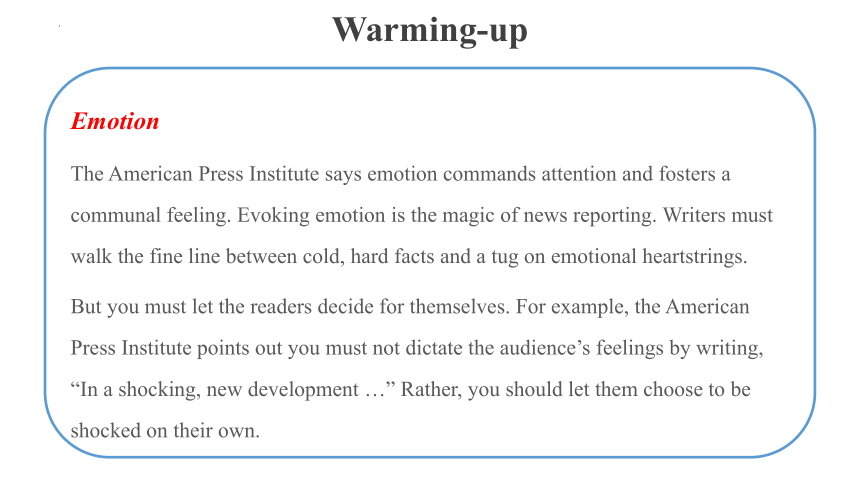
文档简介
(共23张PPT)
Unit 10 Connections
Writing Workshop
A News Report
Warming-up
You are going to write a news report on a school or community event. Discuss these questions with your partner.
1. What event would you like to write about
2. What aspects are you going to include
3. How is a news report normally organised
Warming-up
Warming-up
Warming-up
Tips:
When writing a news report, it’s important to concentrate on four elements — facts, context, impact, and emotion. How you combine these four elements will determine the success of your news story.
3. How is a news report normally organised
Warming-up
Facts:
First, you can hardly call it a news story without the facts. Otherwise, it quickly becomes an opinion piece or a lifestyle article. Not only does the public expect facts over opinions, but they also expect the journalist to follow sound fact-checking procedures.
The facts answer the 5Ws (and H): who, what, where, when, why, and how. A journalist has a responsibility to make sure the facts are accurate and reasonably complete. If you have to write a report before you get all the facts, then say so in the report.
Warming-up
Context
In news writing, context answers the question, “Why should I care ” or, “Why should I read this ” But, from the perspective of the news writer, context helps you decide what the audience needs to know. The American Press Institute cites context as a nice way to gain new readers through an entry point they can relate to. Context provides the circumstances surrounding the facts of the news story.
Warming-up
Impact
Impact touches on the “why we should care” theme too. News writing is, indeed, an art form. Once you take something off the official wire, you have to weave it into a story people will connect with. Impact keeps readers in tune beyond the headline and the lead, or opening sentence. What are the ramifications or potential consequences of this news story How will this series of events affect me and my loved ones
Warming-up
Emotion
The American Press Institute says emotion commands attention and fosters a communal feeling. Evoking emotion is the magic of news reporting. Writers must walk the fine line between cold, hard facts and a tug on emotional heartstrings.
But you must let the readers decide for themselves. For example, the American Press Institute points out you must not dictate the audience’s feelings by writing, “In a shocking, new development …” Rather, you should let them choose to be shocked on their own.
Reading
1. What event is the report about
The first Community Street Festival.
2. When and where did the event happen
On 21 September on Redwood Street.
3. Who attended the event and what did they do
Over 10,000 people from over 20 communities. There were a variety of
acts, most of which were singing and dancing.
4. What did the event bring to the community
The festival gave great pleasure to a large number of people and it brought
together the different communities within our city.
Read the news report and answer the questions.
Reading
Lead Body Round-up
Para. 1 _______ Para. 2 _______ Para. 3 _______ Para. 4 __________
The news report has four paragraphs. Label each paragraph with a function.
Lead
Body
Round-up
Body
Reading
Lead:
highly successful; rather good, well received
Body:
popular; highlight; well organized; enjoyed
Round-up:
gave great pleasure to; “we are eager to participate in next year’s festival.”
Write down all the expressions that convey the fact that the event was a success.
Writing
Sentence Builder
Adverbs of Degree
highly
The festival was highly successful …
rather
The performers were rather good …
mainly
People attending the event were mainly families.
particularly
The acts appealing to children were particularly popular.
Write 2-3 sentences about the event you are going to report. Use the Sentence Builder to help you.
Writing
Tips for Better Writing
In news writing, always follow the inverted pyramid. That is, place the
most pressing facts at the start of the article and close with the least
compelling elements.
Avoid long or complicated words. A news story isn’t the place to impress
people with your intelligence or command of the English language.
Choose short sentences over lengthy sentences that require many forms
of punctuation.
Follow a simple subject-verb-object form.
Don’t use too many commas.
Writing
Each paragraph should introduce a new idea and, like
sentences, be short and to the point. Consider dropping in a
few transition words, where appropriate.
Never use more than two prepositional phrases. These are
phrases like, “According to the national weather forecast …”
Remember that the core objective of a great news report is to convey the fact in a compelling and easy-to-understand manner. Get to the point and use shorter sentences.
Writing
The lead, or the first few sentences, needs to be strong enough to grab the reader’s attention and make them want to read more.
If it’s a hard news story, which is breaking or up-to-the-minute news, then include as many
facts as you can in the summary of the story. If it’s a soft news story, like a human interest
story or background information, then you can place the facts in the body of the story.
Leads tell the reader what the story is about and why it’s important. Beyond that, it tells the
reader why they should read the whole story. Think of it from the perspective of telling a
friend about the latest news.
Write a good lead.
Writing
A common error in leads happens when it focuses on more than one main
idea. When this happens, the reader can’t be sure what the story is about.
Avoid burying the lead (also written as “bury the lead”). This refers to when
you fail to emphasize the most important or most interesting part of the
story, starting out with secondary information first. By its nature, the lead is
meant to lure readers in. If a reader loses interest after the first paragraph,
because you buried the lead in the second or third paragraph, they may not
ever get to why this story should matter to them.
Leads will exclude certain readers if they’re full of jargon. Make sure the news report is suitable for everyone to read.
Writing
Examples of Good Leads
1. “On the second floor of an old Bavarian palace in Munich, Germany, there’s a library with
high ceilings, a distinctly bookish smell and one of the world’s most extensive collections of
Latin texts. About 20 researchers from all over the world work in small offices around the
room.” — Byrd Pinkerton, NPR
2. “A Center City school teacher got enough kisses today to last-well, maybe not a lifetime, but
a few weeks, anyway. Mary Saint Clair kissed 110 men at the annual fund-raiser for the local
zoo. At ten bucks a kiss, she raised eleven hundred dollars for the zoo. When she turned the
money over to zoo officials, she joked that all the animals were not behind bars.” — School
Video News
3. “The million to one shot came in. Hell froze over. A month of Sundays hit the calendar. Don
Larsen today pitched a no- hit, no run, no man reach first game in a World Series.” —
Shirley Povich, Washington Post
Writing
Lead
Body
Round-up
Complete the outline of your news report.
Writing
Writing Help
Writing a News Report
It’s important to:
have an attractive title and a brief lead;
include the who, when, where, what, why and how of the event;
use formal and clear language.
Use your outline and the Writing Help to write your first draft.
Writing
Does the report have a clear title and a brief lead
Does the report clearly introduce the events (Including the who, when, where, what, why and how of the events)
Does the writer use formal and clear language
Edit your report in pairs.
Assignment
Polish your news report.
Goodbye!
Unit 10 Connections
Writing Workshop
A News Report
Warming-up
You are going to write a news report on a school or community event. Discuss these questions with your partner.
1. What event would you like to write about
2. What aspects are you going to include
3. How is a news report normally organised
Warming-up
Warming-up
Warming-up
Tips:
When writing a news report, it’s important to concentrate on four elements — facts, context, impact, and emotion. How you combine these four elements will determine the success of your news story.
3. How is a news report normally organised
Warming-up
Facts:
First, you can hardly call it a news story without the facts. Otherwise, it quickly becomes an opinion piece or a lifestyle article. Not only does the public expect facts over opinions, but they also expect the journalist to follow sound fact-checking procedures.
The facts answer the 5Ws (and H): who, what, where, when, why, and how. A journalist has a responsibility to make sure the facts are accurate and reasonably complete. If you have to write a report before you get all the facts, then say so in the report.
Warming-up
Context
In news writing, context answers the question, “Why should I care ” or, “Why should I read this ” But, from the perspective of the news writer, context helps you decide what the audience needs to know. The American Press Institute cites context as a nice way to gain new readers through an entry point they can relate to. Context provides the circumstances surrounding the facts of the news story.
Warming-up
Impact
Impact touches on the “why we should care” theme too. News writing is, indeed, an art form. Once you take something off the official wire, you have to weave it into a story people will connect with. Impact keeps readers in tune beyond the headline and the lead, or opening sentence. What are the ramifications or potential consequences of this news story How will this series of events affect me and my loved ones
Warming-up
Emotion
The American Press Institute says emotion commands attention and fosters a communal feeling. Evoking emotion is the magic of news reporting. Writers must walk the fine line between cold, hard facts and a tug on emotional heartstrings.
But you must let the readers decide for themselves. For example, the American Press Institute points out you must not dictate the audience’s feelings by writing, “In a shocking, new development …” Rather, you should let them choose to be shocked on their own.
Reading
1. What event is the report about
The first Community Street Festival.
2. When and where did the event happen
On 21 September on Redwood Street.
3. Who attended the event and what did they do
Over 10,000 people from over 20 communities. There were a variety of
acts, most of which were singing and dancing.
4. What did the event bring to the community
The festival gave great pleasure to a large number of people and it brought
together the different communities within our city.
Read the news report and answer the questions.
Reading
Lead Body Round-up
Para. 1 _______ Para. 2 _______ Para. 3 _______ Para. 4 __________
The news report has four paragraphs. Label each paragraph with a function.
Lead
Body
Round-up
Body
Reading
Lead:
highly successful; rather good, well received
Body:
popular; highlight; well organized; enjoyed
Round-up:
gave great pleasure to; “we are eager to participate in next year’s festival.”
Write down all the expressions that convey the fact that the event was a success.
Writing
Sentence Builder
Adverbs of Degree
highly
The festival was highly successful …
rather
The performers were rather good …
mainly
People attending the event were mainly families.
particularly
The acts appealing to children were particularly popular.
Write 2-3 sentences about the event you are going to report. Use the Sentence Builder to help you.
Writing
Tips for Better Writing
In news writing, always follow the inverted pyramid. That is, place the
most pressing facts at the start of the article and close with the least
compelling elements.
Avoid long or complicated words. A news story isn’t the place to impress
people with your intelligence or command of the English language.
Choose short sentences over lengthy sentences that require many forms
of punctuation.
Follow a simple subject-verb-object form.
Don’t use too many commas.
Writing
Each paragraph should introduce a new idea and, like
sentences, be short and to the point. Consider dropping in a
few transition words, where appropriate.
Never use more than two prepositional phrases. These are
phrases like, “According to the national weather forecast …”
Remember that the core objective of a great news report is to convey the fact in a compelling and easy-to-understand manner. Get to the point and use shorter sentences.
Writing
The lead, or the first few sentences, needs to be strong enough to grab the reader’s attention and make them want to read more.
If it’s a hard news story, which is breaking or up-to-the-minute news, then include as many
facts as you can in the summary of the story. If it’s a soft news story, like a human interest
story or background information, then you can place the facts in the body of the story.
Leads tell the reader what the story is about and why it’s important. Beyond that, it tells the
reader why they should read the whole story. Think of it from the perspective of telling a
friend about the latest news.
Write a good lead.
Writing
A common error in leads happens when it focuses on more than one main
idea. When this happens, the reader can’t be sure what the story is about.
Avoid burying the lead (also written as “bury the lead”). This refers to when
you fail to emphasize the most important or most interesting part of the
story, starting out with secondary information first. By its nature, the lead is
meant to lure readers in. If a reader loses interest after the first paragraph,
because you buried the lead in the second or third paragraph, they may not
ever get to why this story should matter to them.
Leads will exclude certain readers if they’re full of jargon. Make sure the news report is suitable for everyone to read.
Writing
Examples of Good Leads
1. “On the second floor of an old Bavarian palace in Munich, Germany, there’s a library with
high ceilings, a distinctly bookish smell and one of the world’s most extensive collections of
Latin texts. About 20 researchers from all over the world work in small offices around the
room.” — Byrd Pinkerton, NPR
2. “A Center City school teacher got enough kisses today to last-well, maybe not a lifetime, but
a few weeks, anyway. Mary Saint Clair kissed 110 men at the annual fund-raiser for the local
zoo. At ten bucks a kiss, she raised eleven hundred dollars for the zoo. When she turned the
money over to zoo officials, she joked that all the animals were not behind bars.” — School
Video News
3. “The million to one shot came in. Hell froze over. A month of Sundays hit the calendar. Don
Larsen today pitched a no- hit, no run, no man reach first game in a World Series.” —
Shirley Povich, Washington Post
Writing
Lead
Body
Round-up
Complete the outline of your news report.
Writing
Writing Help
Writing a News Report
It’s important to:
have an attractive title and a brief lead;
include the who, when, where, what, why and how of the event;
use formal and clear language.
Use your outline and the Writing Help to write your first draft.
Writing
Does the report have a clear title and a brief lead
Does the report clearly introduce the events (Including the who, when, where, what, why and how of the events)
Does the writer use formal and clear language
Edit your report in pairs.
Assignment
Polish your news report.
Goodbye!
同课章节目录
- Unit 10 Connections
- Lesson 1 How Closely Connected Are We?
- Lesson 2 Community Spirit
- Lesson 3 Anne of Green Gables
- Unit 11 Conflict And Compromise
- Lesson 1 Living In a Community
- Lesson 2 Dealing with Conflict
- Lesson 3 War Memories
- Unit 12 Innovation
- Lesson 1 Scientific Breakthroughs
- Lesson 2 Aha Moment
- Lesson 3 Stephen Hawking
